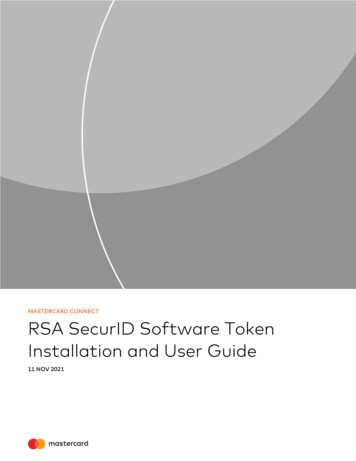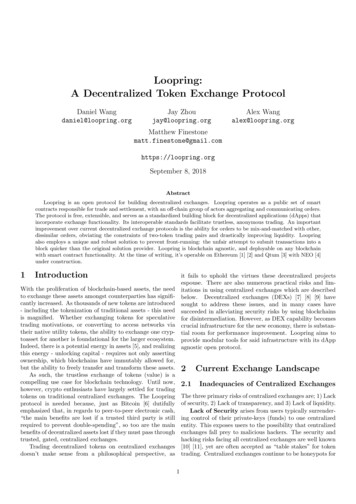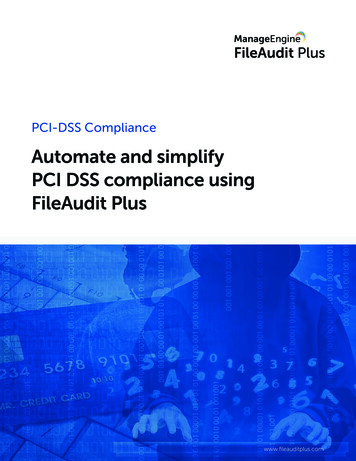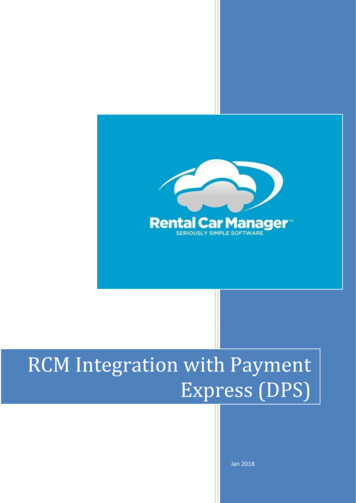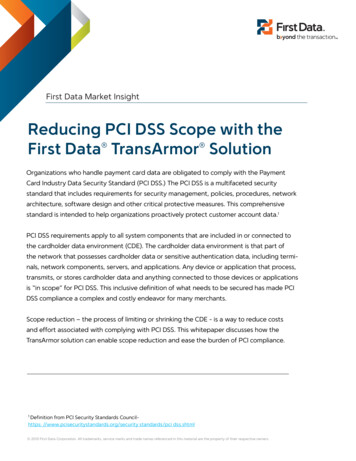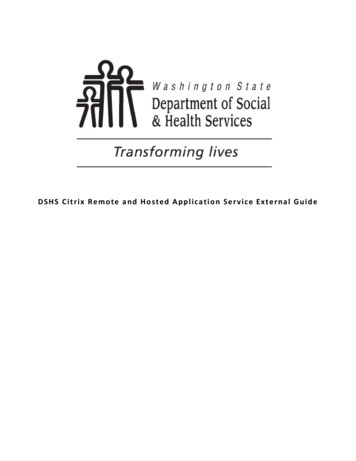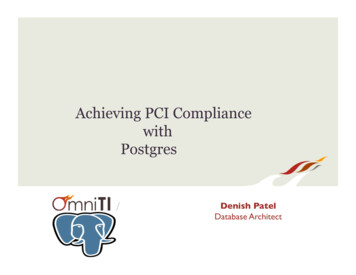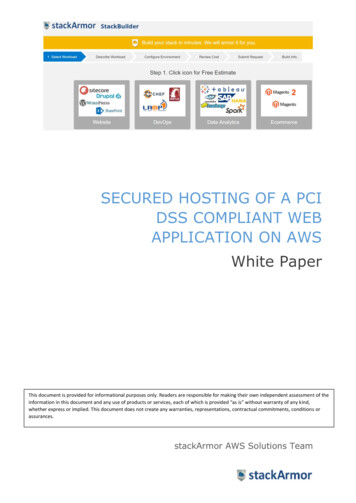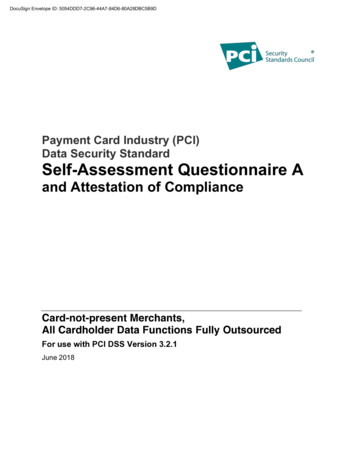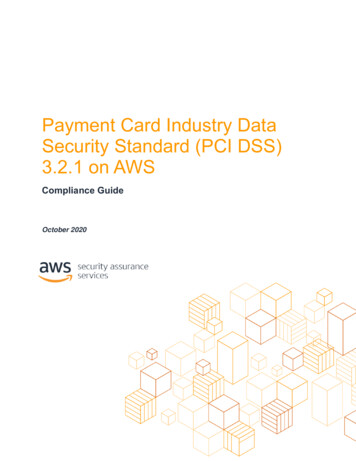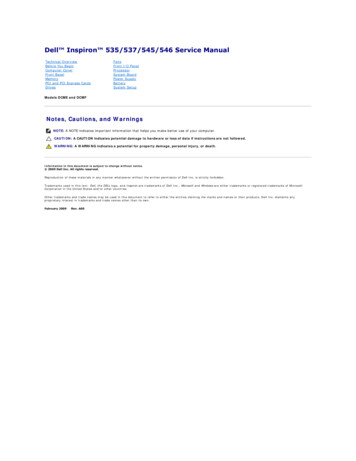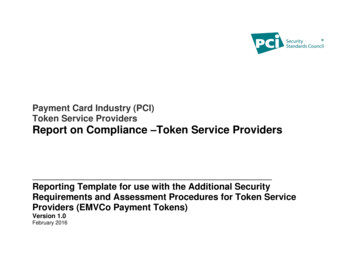
Transcription
Payment Card Industry (PCI)Token Service ProvidersReport on Compliance –Token Service ProvidersReporting Template for use with the Additional SecurityRequirements and Assessment Procedures for Token ServiceProviders (EMVCo Payment Tokens)Version 1.0February 2016
Document ChangesDateVersionDescriptionTo introduce the template for submitting Supplemental Reports on Compliance for TokenisationService ProvidersFebruary 20161.0This document is intended for use with the Additional Requirements and Assessment Procedures forTSPs, v1.0Reporting Template for use with the Additional Requirements and Assessment Procedures for TSPs, v1.0 2016 PCI Security Standards Council, LLC. All Rights Reserved.February 2016Page 2
Table of ContentsDocument Changes .2Introduction to the ROC Template for Payment Card Industry (PCI) Token Service Providers .4Instructions for Submission .4Scope of Requirements .5Examples of TDE/CDE integration within TSP .6Applicability of PCI DSS Requirements 1-12 to TSPs .81.Contact Information and Report Date .101.1 Contact information .101.2 Date and timeframe of assessment .111.3 Additional services provided by QSA company .112.Summary Overview .122.1 Description of the entity’s token services business .122.2 High-level network diagram(s) .122.3 Applicability of PCI DSS Requirements 1-12 to TSPs .132.4 Network segmentation .152.5 Sample sets for reporting .152.6 Documentation reviewed .162.7 Individuals interviewed .172.8 Disclosure summary for “Not Tested” responses.173. Findings and Observations .18TSP 1. Document and validate PCI DSS scope .18TSP 2. Secure TDE Systems and Network .23TSP 3. Protect and manage cryptographic keys .47TSP 4. Restrict access to TDE by business need to know .99TSP 4. Restrict access to TDE by business need to know .99TSP 5. Identify and authenticate all access to TDE systems .101TSP 5. Identify and authenticate all access to TDE systems .101TSP 6. Restrict physical access to the TDE .106TSP 6. Restrict physical access to the TDE .106TSP 7. Monitor all access to TDE .130Reporting Template for use with the Additional Requirements and Assessment Procedures for TSPs, v1.0 2016 PCI Security Standards Council, LLC. All Rights Reserved.February 2016Page 2
TSP 7. Monitor all access to TDE .130TSP 8. Maintain an Information Security Policy .131TSP 8. Maintain an Information Security Policy .131Annex A: Minimum Key Sizes and Equivalent Key Strengths for Approved Algorithms .140Reporting Template for use with the Additional Requirements and Assessment Procedures for TSPs, v1.0 2016 PCI Security Standards Council, LLC. All Rights Reserved.February 2016Page 3
Introduction to the ROC Template for Payment Card Industry (PCI)Token Service ProvidersInstructions for SubmissionThis document, the Reporting Template for use with the PCI Additional Requirements and Assessment Procedures for Token Service Providers,Revision 1.0 (“TSP ROC Template” or “T-ROC”), is the mandatory template for P2PE Qualified Security Assessors (QSAs) completing assessment of aToken Service Provider (as defined by EMVCo) against the PCI Additional Security Requirements and Assessment Procedures for Token ServiceProviders (EMV Payment Tokens), Version 1.0.Note that an entity is ONLY required to undergo an assessment according to this document if instructed to do so by an acquirer or a paymentbrand.This “TSP ROC Template” or “T-ROC” document is to be completed according to the same instructions provided in the Reporting Template for PCI DSSv3. Refer to the Reporting Template(s) for use with PCI DSS v3 and the ROC Reporting Template for PCI DSS v3: Frequently Asked Questions (FAQs)documents on the PCI SSC website for detailed instruction on how to complete these reporting templates. As such, do not delete any content from anyplace in this document, including this section and the versioning above. Excessive personalization and changes to sections – including additionalsections - may not be accepted by accepting entities, and personalization should be limited to the title page.The “T-ROC” template is additional to the ROC Reporting Template, and completion of this T-ROC assumes a ROC Reporting Template for PCI DSShas already been completed. Because of this, details related to Scope of Work, Details of Reviewed Environment and so on that are applicable to theenvironment reviewed for the T-ROC must be included in the applicable sections in the full ROC for that entity. If the PCI DSS ROC does not include alldetails relevant to the TSP Assessment, those additional details must be addressed in a partial ROC or within the T-ROC.Token Service Providers should contact their payment brand and/or acquirer with any questions about completing and submitting these reports.Reporting Template for use with the Additional Requirements and Assessment Procedures for TSPs, v1.0 2016 PCI Security Standards Council, LLC. All Rights Reserved.February 2016Page 4
Scope of RequirementsThe requirements in this document are intended to apply in addition to applicable PCI DSS requirements to the token data environment (TDE). The TDEis a dedicated, secure area within the TSP, where one or more of the following services are performed: Token generation, issuing, and mapping processes Assignment of token usage parameters Token lifecycle management Processes to map or re-map tokens, or perform de-tokenization Cryptographic processes to support tokenization functions Maintenance of underlying token security and related processing controls, such as domain restrictions during transaction processing.These services are critical to the integrity of the Payment Token ecosystem, and the requirements in this document are intended to apply wherever theabove services are performed. Examples of TDE system components that perform these functions include, but are not limited to: Token Vault APIs that support external interactions/interfaces HSMs performing key-management functions for the Token Vault and other tokenization services Systems used to process token-related functions and data, such as token mapping data, token metadata,token domain restriction data, Identification and Verification (ID&V) data, and so on.Note: For a full description of theToken Vault, Payment Tokens,and other terminology, refer to theEMV Payment TokenisationSpecification TechnicalFramework (www.emvco.com).As the TDE contains payment card data, it is also a cardholder data environment (CDE) and subject to thesecurity requirements within PCI DSS as well as the additional security requirements defined within this document.Conceptual illustrations showing two examples of how the TDE is typically integrated into the CDE are provided on the following pages.Reporting Template for use with the Additional Requirements and Assessment Procedures for TSPs, v1.0 2016 PCI Security Standards Council, LLC. All Rights Reserved.February 2016Page 5
Examples of TDE/CDE integration within TSPFigure 1: TDE as a Subnetwork of CDEReporting Template for use with the Additional Requirements and Assessment Procedures for TSPs, v1.0 2016 PCI Security Standards Council, LLC. All Rights Reserved.February 2016Page 6
Figure 2: Combined CDE and TDENote: These diagrams are provided for illustrative purposes only, and do not supersede any PCI DSS requirement. The locations offirewalls in the diagrams are not all-inclusive, and represent the minimum locations where firewall controls exist.Where the CDE and TDE are combined, all CDE components in the TDE must also meet these TSP Requirements.In addition to providing services related to payment card data and Payment Tokens, TSPs often perform other functions or services that include thepresence of Payment Tokens. The requirements in this document only apply to the TDE (as defined and illustrated above), and do not apply to otherenvironments where Payment Tokens exist.Reporting Template for use with the Additional Requirements and Assessment Procedures for TSPs, v1.0 2016 PCI Security Standards Council, LLC. All Rights Reserved.February 2016Page 7
Applicability of PCI DSS Requirements 1-12 to TSPsAs the TDE contains payment card data, it must be PCI DSS compliant. When applying PCI DSS to the TDE, the provisions set forth in this documentalso apply. The applicability of PCI DSS to TSPs extends beyond that described in the “PCI DSS Applicability Information” and “Scope of PCI DSSRequirements” sections within the PCI DSS to also encompass the TDE.Regarding applicability of PCI DSS to Payment Tokens: Within the TDE, Payment Tokens must be secured in the same way as a PAN Outside the TDE, Payment Tokens do not require protection and are not in scope for PCI DSSWhen applying PCI DSS Requirements 1-12 to the TDE, the following principles also apply: Where a PCI DSS requirement specifically mentions the CDE, the requirement also applies to the TDE. Where a PCI DSS requirement specifically mentions PAN or cardholder data (CHD), the requirement also applies to Payment Tokens orPayment Token Data, respectively, within the TDE.A summary of additional considerations for PCI DSS Requirements 1-12 that affect TSPs is provided below.PCI DSS Requirement1.2.3.Additional Applicability for TSPs Firewall controls in PCI DSS Requirement 1 also apply to internal firewalls used toseparate TDE from non-TDE networks. The current network and data flow diagrams (PCI DSS Requirements 11.2 and1.1.3) must also include all connections between the TDE and other networks, andall flows of Payment Tokens across systems and networks in the TDE.Do not use vendor-supplied defaults for systempasswords and other security parameters PCI DSS Requirement 2 applies to all system components in the TDE. Wireless environments are not permitted to be connected to the TDE.Protect stored cardholder data Data retention and disposal policies, procedures and processes (PCI DSSRequirement 3.1) also apply to Payment Token Data. Payment Tokens must also be masked when displayed such that only personnelwith a legitimate business need can see the full Payment Token (PCI DSSRequirement 3.3), and rendered unreadable wherever they are stored (PCI DSSRequirement 3.4) in the TDE. The key-management requirements in this document are in addition to those inPCI DSS Requirements 3.5 – 3.6Install and maintain a firewall configuration toprotect cardholder dataReporting Template for use with the Additional Requirements and Assessment Procedures for TSPs, v1.0 2016 PCI Security Standards Council, LLC. All Rights Reserved.February 2016Page 8
PCI DSS RequirementAdditional Applicability for TSPs4.Encrypt transmission of cardholder data acrossopen, public networks Wireless environments are not permitted to be connected to the TDE.5.Protect all systems against malware andregularly update anti-virus software or programs PCI DSS Requirement 5 applies to all system components in the TDE.6.Develop and maintain secure systems andapplications PCI DSS Requirement 6 applies to all system components in the TDE. All changes made to system components in the TDE must be in accordance withPCI DSS Requirement 6.4.5.7.Restrict access to cardholder data by businessneed to know Access to Payment Token Data in the TDE must also be restricted according toprinciples of need-to-know and least privilege.8.Identify and authenticate access to systemcomponents Strong authentication controls are required for all accounts used to accessPayment Tokens or to access systems in the TDE.9.Restrict physical access to cardholder data Physical security controls also apply to secure access to Payment Token Data inthe TDE.10. Track and monitor all access to networkresources and cardholder data Audit log requirements include all individual user access to Payment Token Data inthe TDE (PCI DSS Requirement 10.2.1).11. Regularly test security systems and processes Internal vulnerability scans, penetration tests (for example, to verify segmentationcontrols), intrusion detection, and change detection apply to the TDE.12. Maintain a policy that addresses informationsecurity for all personnel PCI DSS Requirement 12 also applies to personnel with access to the TDE.Reporting Template for use with the Additional Requirements and Assessment Procedures for TSPs, v1.0 2016 PCI Security Standards Council, LLC. All Rights Reserved.February 2016Page 9
T-ROC Template for Token Service ProvidersThis template is to be used for creating a TSP Report on Compliance. Content and format for a T-ROC is defined as follows:1. Contact Information and Report Date1.1 Contact informationClient Company name: Company address: Company URL: Company contact name: Contact phone number: Contact e-mail address:Assessor Company Company name: Company address: Company website:Assessor Assessor name: Assessor PCI credentials:(QSA, PA-QSA, etc.) Assessor phone number: Assessor e-mail address:Assessor Quality Assurance (QA) Primary Reviewer for this specific report (not the general QA contact for the QSA) QA reviewer name: QA reviewer phone number: QA reviewer e-mail address:Reporting Template for use with the Additional Requirements and Assessment Procedures for TSPs, v1.0 2016 PCI Security Standards Council, LLC. All Rights Reserved.February 2016Page 10
1.2 Date and timeframe of assessment Date of Report: Timeframe of assessment (start date to completion date): Identify date(s) spent onsite at the entity: Descriptions of time spent onsite at the entity and time spent performingremote assessment activities, including time spent on validation ofremediation activities.1.3 Additional services provided by QSA companyThe PCI DSS Validation Requirements for QSAs v2.0, Section 2.2 “Independence” specifies requirements for QSAs around disclosure of such servicesand/or offerings that could reasonably be viewed to affect independence of assessment. Complete the below after review of this portion of the ValidationRequirements, to ensure responses are consistent with documented obligations. Disclose all services offered to the assessed entity by the QSAC, includingbut not limited to whether the assessed entity uses any security-relateddevices or security-related applications that have been developed ormanufactured by the QSA, or to which the QSA owns the rights or that theQSA has configured or manages: Describe efforts made to ensure no conflict of interest resulted from theabove mentioned services provided by the QSAC:Reporting Template for use with the Additional Requirements and Assessment Procedures for TSPs, v1.0 2016 PCI Security Standards Council, LLC. All Rights Reserved.February 2016Page 11
2. Summary Overview2.1 Description of the entity’s token services businessProvide an overview of the entity’s token services business: Describe the nature of the entity’s business (what kind of work they do, etc.)Note: This is not intended to be a cut-and-paste from the entity’s website, butshould be a tailored description that shows the assessor understands the businessof the entity being assessed.2.2 High-level network diagram(s)Provide a high-level network diagram (either obtained from the entity or created by assessor) of the entity’s networking topography, showing theoverall architecture of the environment being assessed. This high-level diagram should summarize all locations and key systems, and the boundariesbetween them and should include the following: Connections into and out of the network including demarcation points between the token data environment (TDE) and other networks/zones Critical components within the token data environment, including (but not limited to) oToken vaultoAPIs that support external interactions/interfacesoHSMs performing key-management functions for the Token Vault and other tokenization servicesoSystems used to process token-related functions and data, such as token mapping data, token metadata, token domain restriction data,Identification and Verification (ID&V) data, and so on.Other necessary payment components, as applicable Insert high-level network diagram(s) Reporting Template for use with the Additional Requirements and Assessment Procedures for TSPs, v1.0 2016 PCI Security Standards Council, LLC. All Rights Reserved.February 2016Page 12
2.3Applicability of PCI DSS Requirements 1-12 to TSPsConfirm whether the additional considerations for PCI DSS Requirements 1-12 that affect TSPs below were included in the PCI DSS Assessment or assessedseparately. Include the date of the assessment.Note: If the TSP assessor was unable to confirm that the TDE was assessed fully, a partial ROC must be completed to address those TDE portions deemednecessary.Indicate whether each item below was assessed and verified as being met during this TSP engagement or in a separate PCI DSS engagement.Assessed and verified as beingmet during this TSP engagementAssessed and verified as being metin a separate PCI DSS engagementas documented on Date 1. Install and maintain a firewall configuration to protect cardholder data Firewall controls in PCI DSS Requirement 1 were assessed and verified forinternal firewalls used to separate TDE from non-TDE networks. The current network and data flow diagrams (PCI DSS Requirements 11.2and 1.1.3) were assessed and verified to include all connections between theTDE and other networks, and all flows of Payment Tokens across systemsand networks in the TDE. Data retention and disposal policies, procedures and processes (PCI DSSRequirement 3.1) were assessed and verified to include Payment TokenData. Payment Tokens were assessed and verified to be masked when displayedsuch that only personnel with a legitimate business need can see the fullPayment Token (PCI DSS Requirement 3.3), and rendered unreadablewherever they are stored (PCI DSS Requirement 3.4) in the TDE. Key-management requirements in this document were assessed and verifiedin addition to those in PCI DSS Requirements 3.5 – 3.6 2. Do not use vendor-supplied defaults for system passwords and other security parameters PCI DSS Requirement 2 was assessed and verified for all systemcomponents in the TDE.3. Protect stored cardholder data 4. Encrypt transmission of cardholder data across open, public networksReporting Template for use with the Additional Requirements and Assessment Procedures for TSPs, v1.0 2016 PCI Security Standards Council, LLC. All Rights Reserved.February 2016Page 13
The TDE was verified as not having any wireless environments connected 5. Protect all systems against malware and regularly update anti-virus software or programs PCI DSS Requirement 5 was assessed and verified for all systemcomponents in the TDE.6. Develop and maintain secure systems and applications PCI DSS Requirement 6 was assessed and verified for all systemcomponents in the TDE. Changes made to system components in the TDE were assessed andverified to be in accordance with PCI DSS Requirement 6.4.5. 7. Restrict access to cardholder data by business need to know Access to Payment Token Data in the TDE was assessed and verified to berestricted according to principles of need-to-know and least privilege.8. Identify and authenticate access to system components All accounts used to access Payment Tokens or to access systems in theTDE were assessed and verified to require strong authentication controls.9. Restrict physical access to cardholder data Physical security controls were assessed and verified to secure access toPayment Token Data in the TDE.10. Track and monitor all access to network resources and cardholder data Audit log requirements were assessed and verified to include all individualuser access to Payment Token Data in the TDE (PCI DSS Requirement10.2.1).11. Regularly test security systems and processes Internal vulnerability scans, penetration tests (for example, to verifysegmentation controls), intrusion detection, and change detection wereassessed and verified for the TDE.12. Maintain a policy that addresses information security for all personnel PCI DSS Requirement 12 was assessed and verified for personnel withaccess to the TDE.Reporting Template for use with the Additional Requirements and Assessment Procedures for TSPs, v1.0 2016 PCI Security Standards Council, LLC. All Rights Reserved.February 2016Page 14
2.4Network segmentation Identify whether the TDE is combined with the CDE (yes/no)If “yes,” mark the remainder of this section as “Not Applicable” Identify whether the TDE is a subnetwork of the CDE (yes/no)If “no,” complete the following: Briefly describe how the segmentation is implemented. Identify the technologies used and any supporting processes Explain how the assessor validated the effectiveness of the segmentation, as follows:(a) Describe the methods used to validate the effectiveness of thesegmentation (for example, observed configurations of implementedtechnologies, tools used, network traffic analysis, etc.).(b) Describe how it was verified that the segmentation is functioning asintended.(c) Describe how it was verified that adequate security controls are in placeto ensure the integrity of the segmentation mechanisms (e.g., accesscontrols, change management, logging, monitoring, etc.). Provide the name of the assessor who attests that the segmentation wasverified to be adequate to reduce the scope of the assessment AND that thetechnologies/processes used to implement segmentation were included in thePCI DSS assessment.2.5 Sample sets for reportingNote: When a reporting instruction asks for a sample, the assessor may either refer to the Sample Set Identifier here (for example “SampleSet-1”) OR list the sampled items individually in the response. Examples of sample sets may include, but are not limited to, firewalls,application servers, retail locations, data centers, User IDs, people, etc. Add rows as needed.Sample SetReference NumberSample Type/ Description(e.g., firewalls, datacenters, etc.)Listing of all components (devices,locations, etc.) of the Sample Set(with make/model, as applicable)TotalSampledTotalPopulationSample Set-1Reporting Template for use with the Additional Requirements and Assessment Procedures for TSPs, v1.0 2016 PCI Security Standards Council, LLC. All Rights Reserved.February 2016Page 15
Sample SetReference NumberSample Type/ Description(e.g., firewalls, datacenters, etc.)Listing of all components (devices,locations, etc.) of the Sample Set(with make/model, as applicable)TotalSampledTotalPopulationSample Set-2Sample Set-3Sample Set-42.6 Documentation reviewedIdentify and list all reviewed documents. Include the following:ReferenceNumberDocument Name(including version, if applicable)Brief description of document purposeDocument date(latest version date)Doc-1Doc-2Doc-3Doc-4Doc-5Reporting Template for use with the Additional Requirements and Assessment Procedures for TSPs, v1.0 2016 PCI Security Standards Council, LLC. All Rights Reserved.February 2016Page 16
2.7Individuals interviewedIdentify and list the individuals interviewed. Include the following:ReferenceNumberEmployee NameRole/Job TitleOrganizationIs this personan ISA?(yes/no)Summary of Topics Covered / Areas orSystems of Expertise(high-level summary only)Int-1Int-2Int-3Int-42.8Disclosure summary for “Not Tested” responses Identify whether there were any responses indicated as “NotTested”: (yes/no) If “yes,” complete the table below:Summary of the issueList of all requirements/testing procedures with this result(for example, not deemed in scope for the assessment)Reporting Template for use with the Additional Requirements and Assessment Procedures for TSPs, v1.0 2016 PCI Security Standards Council, LLC. All Rights Reserved.February 2016Page 17
3. Findings and ObservationsTSP 1. Document and validate PCI DSS scopeTSP 1. Document and validate PCI DSS scopeSummary of Assessment Findings(check one)Requirements and Testing ProceduresReporting Instructions &Assessor’s FindingsInPlaceIn Placew/ CCWN/ANot inPlace TSP 1.1 Document and validate scope for PCI DSS and TSP RequirementsTSP 1.1.1 Document and confirm the accuracy of scope for PCI DSS and these TSP Requirements at least quarterlyand upon significant changes to the in-scope environment. At a minimum, the quarterly scoping validation must include: Identifying all in-scope networks and system components Identifying all out-of-scope networks and justification for networks being out of scope, including descriptions of allsegmentation controls implemented Identifying all connected entities—e.g., third-party entities with access to the TDE and/or CDETSP 1.1.1.a Examine documented results of scope reviews and interviewpersonnel to verify that the reviews are performed: At least quarterly After significant changes to the in-scope environmentTSP 1.1.1.b Examine documented results of quarterly scope reviews toverify the following is performed: Identification of all in-scope networks and system components Identification of all out-of-scope networks and justification for networksbeing out of scope, including descriptions of all segmentation controlsimplemented Identification of all connected entities—e.g., third-party entities withaccess to the TDE and/or CDEIdentify the documented results ofscope reviews examined for thistesting procedure. Report Findings Here Identify the personnel interviewed forthis testing procedure. Report Findings Here Identify the quarterly scope reviewdocument(s) examined for this testingprocedure. Report Findings Here Reporting Template for use with the Additional Requirements and Assessment Procedures for TSPs, v1.0 2016 PCI Security Standards Council, LLC. All Rights Reserved.February 2016Page 18
TSP 1. Document and validate PCI DSS scopeSummary of Assessment Findings(check one)Reporting Instructions &Assessor’s FindingsRequirements and Testing ProceduresInPlaceIn Placew/ CCWN/ANot inPlace TSP 1.1.2 Determine scope impact for PCI DSS and TSP Requirements, for all changes to systems or networks,including additions of new systems and new network connections. Processes must include: Performing a formal impact assessment for PCI DSS and these TSP Requirements Identifying applicable requirements for the affected system or network Up
This document, the Reporting Template for use with the PCI Additional Requirements and Assessment Procedures for Token Service Providers, Revision 1.0 ("TSP ROC Template" or "T-ROC"), is the mandatory template for P2PE Qualified Security Assessors (QSAs) completing assessment of a
